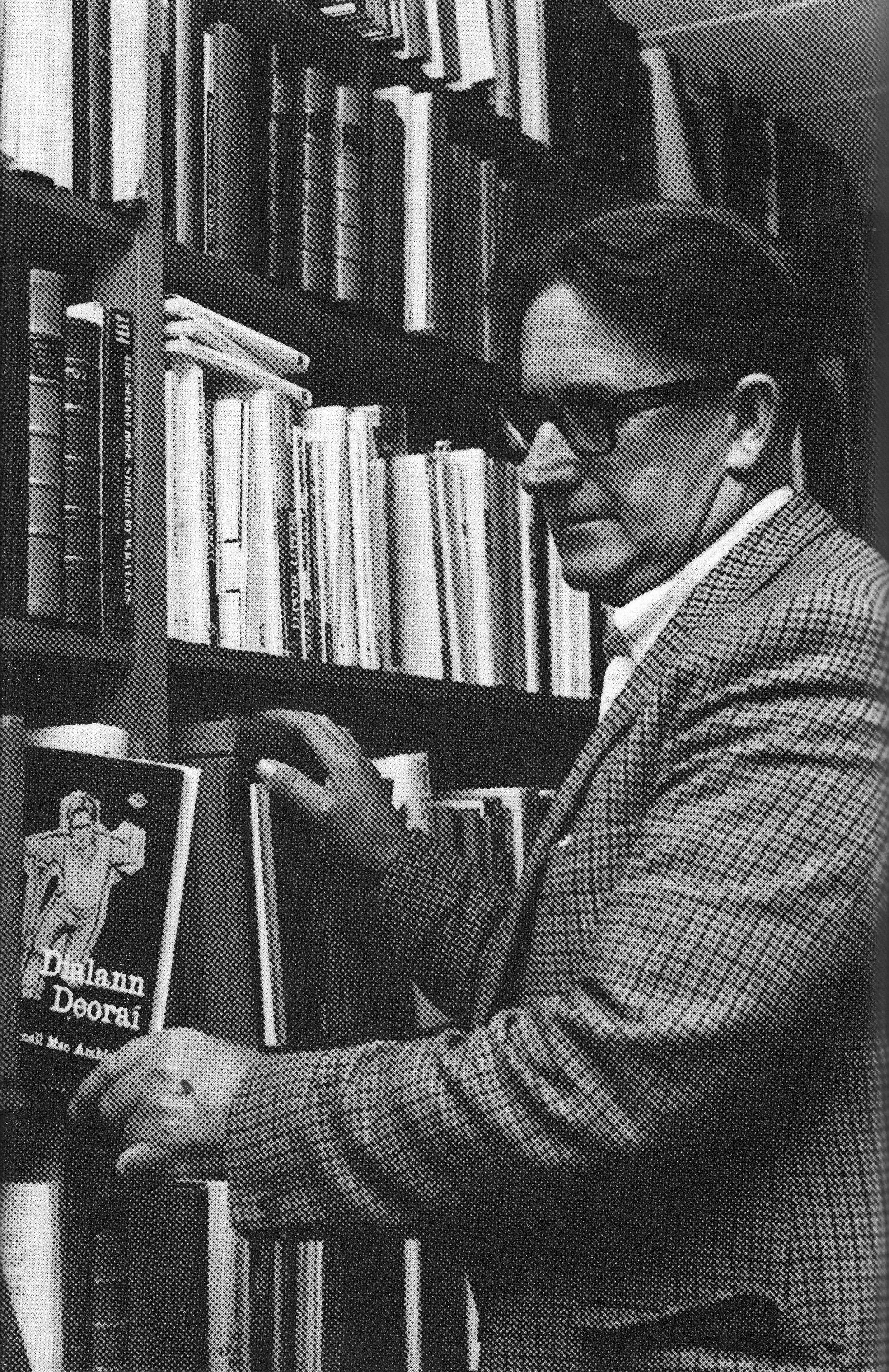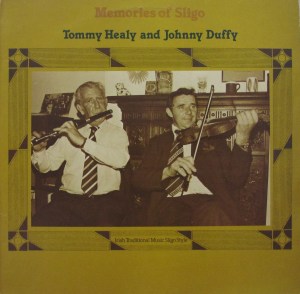Dónall Mac Amhlaigh and ‘The Middle Nation’
Another post from The Dustbin of History, 15 August 2013.

Galway-born Dónall Mac Amhlaigh (1926-1989) is perhaps best known as the author of Dialann Deoraí, first published in 1960 and translated into English as An Irish Navvy, a record of his experiences working in England in the 1950s. This frequently referenced work established him as a dominant voice of Irishmen in Britain, but he left a much broader legacy.[1] Máirín Nic Eoin has written about his works of fiction, most of which have a strong autobiographical bent, but his extensive body of journalistic prose remains largely unexamined.[2] Unfortunately historians and literary scholars alike have even further marginalized his untranslated Irish works due to lack of familiarity or engagement with the language.[3] These omissions seem particularly grave given that Mac Amhlaigh himself expressed dissatisfaction with Dialann Deoraí, calling it ‘a great lost opportunity’ because he felt he did not take full advantage of the ‘rich, virtually unworked subject’.[4] He viewed his last novel, Deoraithe [Exiles], a fictional (though autobiographically-based) treatment of the same topic, as a way to ‘make good’ this earlier fault.[5]
In the intervening years Mac Amhlaigh continued to write prolifically and his journalism shows the development of his social and political consciousness. Between 1966 and 1988 he wrote roughly 200 articles for the Irish Times in both Irish and English. These presented the experience of the Irish in Britain, from the perspective of a working-class urban Gaeilgeoir, primarily to an Irish audience who had remained in Ireland. This post examines a series of three articles published in October 1970 titled ‘The Middle Nation’, which takes the form of observational, and at times sharply critical, social commentary.[6] Mac Amhlaigh seeks to explain the difficult and ambiguous position of the Irish in Britain and in doing so addresses persistent class divisions among the immigrants and differing levels of attachment, or lack thereof, felt by members of that group to their heritage. Though written in 1970 he focused on his own generation, those who had come to Britain in the post-war years, and while the focus on male labourers in Dialann Deoraí has been perceived as homogenizing the image of this cohort, he clearly recognized its diversity.
As the word ‘middle’ in the title suggests, a primary theme of the series is the feeling of liminality, of belonging fully neither to Ireland nor Britain. In the first article Mac Amhlaigh addresses the issue of adjustment to life in Britain, questioning the nature of ‘assimilation’. He lambasts equally the Irish who ape British ways and those who seem in denial of the fact that they live in Britain. The former he stereotypes as:
People who “muck in” in village or suburban life, who get on committees, on dart teams, pay into divvi-clubs for Christmas and go on coach-outings to the seaside where they do a “Knees Up, Mother Brown” as good as any Cockney; who rarely read an Irish paper, bother their heads about Irish affairs, try to tune into Radio Éireann or sing a bit of an Irish song. Men who talk of foreigners, wogs and – so help me, God! – of Paddies, even![7]
Though he admits ‘they are not all so objectionable as this’, what bothers him about them is their ‘complete and wholehearted apostasy’, their abandonment of their Irishness. Though he hesitates to draw firm conclusions without ‘concrete evidence’ of statistics, he suggests that this type of person tends to be of the ‘professional and business’ class.[8] On the other hand,
There are a great many of our people who have never really come to terms with their exile, people to whom after nearly forty years of residence in England the day-old Irish newspaper is of more interest than the Mirror or the Express… who are, in speech and thought and manner, as uncompromisingly Irish as the day they left home… and these are the real casualties of Emigration, the ones who won’t or can’t integrate.[9]
This latter position seems equally reprehensible. What he criticizes in both extreme cases is the failure to acknowledge or even embrace liminal status, the failure to admit (or even take pride in) Irish heritage while also facing the realities of living abroad.
The second part of the title, ‘nation’, also poses somewhat of a paradox because while the term implies a degree of unity, the Irish in Britain comprise a heterogeneous group. Mac Amhlaigh addresses head-on issues of class divisions in the second article in the series, ‘Social Life and the Emigrant’:
It was Honor Tracy, I think, who remarked upon the almost pathological fear of some of the Irish abroad of coming into contact with each other. One would perhaps need to be Irish to appreciate this fully, to understand the vagaries of class-consciousness based less on real rank or wealth than upon an unshakeable belief in one’s superiority to another – however intangible the basis for the assumption (emphasis added).[10]
If attempting to create a ‘nation’ or sense of cohesion among an immigrant group, clearly these divisions carried over from rural Irish society are problematic whether real or imagined. To this he adds factors of ‘apathy, indifference and the traditional Irish failure to agree on things’.[11] He argues that though social organizations existed and the Irish Post (the newspaper of the Irish in Britain) might cover the functions they organized, these were formal rather than ‘free-and-easy’ affairs. From his own experience he suggests that even people from the same locality in Ireland resist associating with one another outside a close group of relatives: ‘without exception, these people will say of each other: A níl aon nádúr ionntab sín, tá siad coimhthioch – “There’s no nature in them, they’re standoffish.”’[12] He feels no compunction in criticizing them for it, for their unwillingness ‘to take the first step’ or to break out of the ‘world of taboos, of inhibitions,’ of the ‘smothering conformity which forbade them to think as individuals’.[13] Clearly he thought life in Britain offered an opportunity to develop new perspectives and lamented the failure of many to embrace that chance.
However, despite these shortcomings in the final article in the series, ‘Finding Our Feet’, Mac Amhlaigh does offer hope of redemption. He believes that Irish immigrants have made progress and argues that they are (in 1970) more comfortable with their place in British society than even a decade previously:
It is very evident that our exiles are fast shedding that extreme touchiness – well enough justified in the past, no doubt, but which sometimes bordered on paranoia – and are now able to make a more mature appraisal of themselves and of their position in what has come to be known as the host community (emphasis added).[14]
He says he has witnessed changing attitudes both of the Irish towards the English and vice versa. This includes ‘a change in our estimation of ourselves’ from ‘a sense of insecurity’ to a feeling of more ‘assurance’. However, the spectre of the Troubles and its potential impact lurked in his mind and he states that ‘barring a worsening of the Northern situation we will become steadily more identifiable with our hosts’.[15] However, this does not imply forgetting their origins and the article concludes with the hope that ‘emigration may continue to fall off and that once more we may be able to restock the great lonely spaces of Ireland,’ evoking the image of emigrants since the famine as ‘the vanishing Irish’ and on the eve of a (brief) reversal of those trends.[16]
Though he attempts to resolve the issue of being both Irish and living in Britain, arguing that dual identity or loyalty is indeed possible, there is still an ambivalence towards always remaining ‘the middle nation’. In an interview in the 1980s he said that ‘most of us, even though we’ve lived in Britain, and seen our children grow up here, could never give our hearts to this country in the same way we could to Australia or New Zealand or some place like that, because of the history’.[17] He says he has no anti-English feelings but, speaking for the Irish in Britain as a whole, there is a lingering sense of equivocation: ‘We have that feeling, on the one hand, of a certain amount of gratitude, if gratitude isn’t misplaced, that we got work here when we couldn’t have got it at home, and on the whole we’ve lived reasonably well here… On the other hand there’s the fact of finding ourselves in a country we might perhaps rather not be in.’[18] He certainly was not alone in expressing this sentiment and Liam Harte argues that ‘the dialectical tension between adherence to a fixed originary identity and the evolution of a flexible, contingent migrant identity’ is one of the ‘central tropes’ in the literature of the Irish in Britain, though each author gives it an individual colour.[19] Mac Amhlaigh’s ‘The Middle Nation’ series is a perceptive example of how the personal reflections contained in his journalism can contribute to our understanding of the experiences of the post-war emigrant generation and its evolving sense of identity. In the now more widely recognized and growing body of writing by and on the Irish in Britain Dónall Mac Amhlaigh’s voice remains unique and deserving of attention in its own right.
[1] On Dialann Deoraí see: Bernard Canavan, ‘Story-tellers and Writers: Irish Identity in Emigrant Labourers’ Autobiographies, 1870-1970’, in Patrick O’Sullivan (ed.), The Irish World Wide: History, Heritage, Identity. Vol. 3, The Creative Migrant (Leicester University Press, London, 1994), pp.162-5; Tony Murray, London Irish Fictions (Liverpool University Press, Liverpool, 2012), pp.79-85; Clair Wills, ‘Realism and the Irish Immigrant: Documentary, Fiction, and Postwar Irish Labor’, Modern Language Quarterly, vol.73, no.3 (Sept. 2012), pp.373-94.
[2] Máirín Nic Eoin, ‘An Scríobhneoir agus an Imirce Éigeantach: Scrúdú ar Shaothar Cruthaitheach Dhónaill Mhic Amhlaigh’, Oghma 2 (1990), pp.92-104.
[3] Though historians and literary scholars frequently quote and cite An Irish Navvy, it is almost always the English translation rather than the original (as is the case in the works listed in footnote 1).
[4] Dónall Mac Amhlaigh, ‘Documenting the Fifties’, Irish Studies in Britain, no.14 (Spring/Summer 1989), p.9.
[5] Dónall Mac Amhlaigh, in Nigel Gray (ed.), Writers Talking (London: Caliban Books, 1989), p.181.
[6] The drawings that accompany these articles are also very interesting, but unfortunately copyright prevents me from reproducing them here. They are worth looking up if you have access to the Irish Times via the ProQuest Historical Newspapers archive.
[7] Dónall Mac Amhlaigh, ‘The Middle Nation’, Irish Times, 14 Oct. 1970.
[8] Ibid.
[9] Ibid.
[10] Dónall Mac Amhlaigh, ‘Social Life and the Emigrant’, Irish Times, 15 Oct. 1970.
[11] Ibid.
[12] Ibid.
[13] Ibid.
[14] Dónall Mac Amhlaigh, ‘Finding Our Feet’, Irish Times, 16 Oct. 1970.
[15] Ibid.
[16] Ibid.
[17] Dónall Mac Amhlaigh, in Gray (ed.), Writers Talking, p.181.
[18] Ibid.
[19] Liam Harte, ‘“You want to be a British Paddy?”: The Anxiety of Identity in Post-war Irish Migrant Writing’, in Dermot Keogh, Finbarr O’Shea & Carmel Quinlan (eds.), The Lost Decade: Ireland in the 1950s (Mercier, Douglas Village, Cork, 2004), p.234, p.236. He also makes the problematic assertion that ‘while migrant writers of the 1950s such as Dónall Mac Amhlaigh and John B. Keane are primarily concerned with chronicling the loneliness and alienation of the Irish in post-war England, Walter Macken and Tom Murphy focus on the dilemmas faced by migrant protagonists who wish to evolve new narratives of belonging’ (p.238). While that may be true of Dialann Deoraí (the only work of Mac Amhlaigh’s that Harte cites in relation to that statement), it does not hold true for all of Mac Amhlaigh’s later work.
